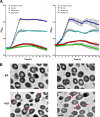Ethanolamine Utilization and Bacterial Microcompartment Formation Are Subject to Carbon Catabolite Repression
- PMID: 30833356
- PMCID: PMC6482927
- DOI: 10.1128/JB.00703-18
Ethanolamine Utilization and Bacterial Microcompartment Formation Are Subject to Carbon Catabolite Repression
Abstract
Ethanolamine (EA) is a compound prevalent in the gastrointestinal (GI) tract that can be used as a carbon, nitrogen, and/or energy source. Enterococcus faecalis, a GI commensal and opportunistic pathogen, contains approximately 20
Keywords: bacterial microcompartments; carbon catabolite repression; enterococcus; ethanolamine utilization.
Copyright © 2019 American Society for Microbiology.
Figures







Similar articles
-
Ethanolamine-induced assembly of microcompartments is required for Fusobacterium nucleatum virulence.mBio. 2025 Feb 5;16(2):e0340524. doi: 10.1128/mbio.03405-24. Epub 2024 Dec 23. mBio. 2025. PMID: 39714188 Free PMC article.
-
CcpA represses the expression of the divergent cit operons of Enterococcus faecalis through multiple cre sites.BMC Microbiol. 2011 Oct 11;11:227. doi: 10.1186/1471-2180-11-227. BMC Microbiol. 2011. PMID: 21989394 Free PMC article.
-
Bacterial microcompartment utilization in the human commensal Escherichia coli Nissle 1917.J Bacteriol. 2024 Dec 19;206(12):e0026924. doi: 10.1128/jb.00269-24. Epub 2024 Dec 5. J Bacteriol. 2024. PMID: 39636254 Free PMC article.
-
Ethanolamine Utilization in Bacteria.mBio. 2018 Feb 20;9(1):e00066-18. doi: 10.1128/mBio.00066-18. mBio. 2018. PMID: 29463652 Free PMC article. Review.
-
Transcriptional and Post Transcriptional Control of Enterococcal Gene Regulation.2014 Feb 12. In: Gilmore MS, Clewell DB, Ike Y, Shankar N, editors. Enterococci: From Commensals to Leading Causes of Drug Resistant Infection [Internet]. Boston: Massachusetts Eye and Ear Infirmary; 2014–. 2014 Feb 12. In: Gilmore MS, Clewell DB, Ike Y, Shankar N, editors. Enterococci: From Commensals to Leading Causes of Drug Resistant Infection [Internet]. Boston: Massachusetts Eye and Ear Infirmary; 2014–. PMID: 24649509 Free Books & Documents. Review.
Cited by
-
Isolation and characterization of a novel choline degrading Citrobacter amalonaticus strain from the human gut.Curr Res Microb Sci. 2022 Jul 29;3:100157. doi: 10.1016/j.crmicr.2022.100157. eCollection 2022. Curr Res Microb Sci. 2022. PMID: 36518168 Free PMC article.
-
Manganese Depletion Leads to Multisystem Changes in the Transcriptome of the Opportunistic Pathogen Streptococcus sanguinis.Front Microbiol. 2020 Nov 5;11:592615. doi: 10.3389/fmicb.2020.592615. eCollection 2020. Front Microbiol. 2020. PMID: 33250881 Free PMC article.
-
Robust Synthetic Biology Toolkit to Advance Carboxysome Study and Redesign.ACS Synth Biol. 2025 Jun 20;14(6):2219-2229. doi: 10.1021/acssynbio.5c00144. Epub 2025 Jun 9. ACS Synth Biol. 2025. PMID: 40488673 Free PMC article.
-
Polyamine and Ethanolamine Metabolism in Bacteria as an Important Component of Nitrogen Assimilation for Survival and Pathogenicity.Med Sci (Basel). 2022 Jul 29;10(3):40. doi: 10.3390/medsci10030040. Med Sci (Basel). 2022. PMID: 35997332 Free PMC article. Review.
-
Influence of the Alternative Sigma Factor RpoN on Global Gene Expression and Carbon Catabolism in Enterococcus faecalis V583.mBio. 2021 May 18;12(3):e00380-21. doi: 10.1128/mBio.00380-21. mBio. 2021. PMID: 34006651 Free PMC article.
References
-
- White DA. 1973. Phospholipid composition of mammalian tissues, p 441–482. In Ansell GB, Hawthorne JN, Dawson RMC (ed), Form and function of phospholipids. Elsevier, New York, NY.
-
- Bertin Y, Girardeau JP, Chaucheyras-Durand F, Lyan B, Pujos-Guillot E, Harel J, Martin C. 2011. Enterohaemorrhagic Escherichia coli gains a competitive advantage by using ethanolamine as a nitrogen source in the bovine intestinal content. Environ Microbiol 13:365–377. doi: 10.1111/j.1462-2920.2010.02334.x. - DOI - PubMed
Publication types
MeSH terms
Substances
Grants and funding
LinkOut - more resources
Full Text Sources

